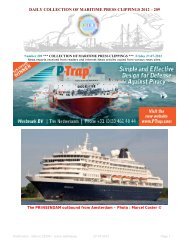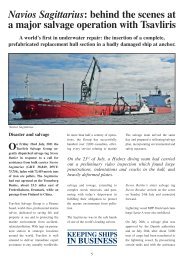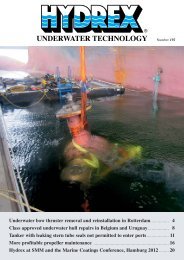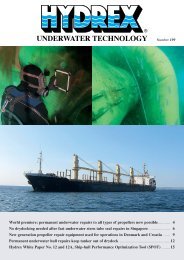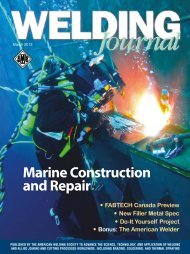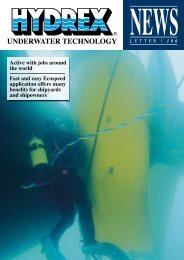Ecospeed newsletter December 2012 - Hydrex Underwater ...
Ecospeed newsletter December 2012 - Hydrex Underwater ...
Ecospeed newsletter December 2012 - Hydrex Underwater ...
Create successful ePaper yourself
Turn your PDF publications into a flip-book with our unique Google optimized e-Paper software.
NEWS<br />
Number 187<br />
L E T T E R<br />
<strong>Ecospeed</strong> comes out on top after two year test on dredger ........................................... 3<br />
<strong>Ecospeed</strong> rudder applications prevent cavitation damage............................................. 5<br />
Eliminating hull-borne aquatic invasive species................................................................... 7
Total Protection<br />
The rudder of MV Elisabeth Russ before<br />
<strong>Ecospeed</strong> was applied in 2004, showing heavy<br />
cavitation damage.<br />
Ships have been sailing for up to nine<br />
years (and counting) with <strong>Ecospeed</strong><br />
without having to replace the coating on<br />
their rudders or having to opt for important<br />
and costly steel repairs.<br />
<strong>Ecospeed</strong> can be applied on a rudder at a very<br />
low cost, especially compared with the large<br />
The rudder of MV Elisabeth Russ in drydock<br />
in 2011. No further cavitation damage has<br />
occurred in the intervening 7 years.<br />
drydock costs. It will give a rudder supreme<br />
protection against cavitation and corrosion<br />
damage for the rest of the vessel’s service life.<br />
<strong>Ecospeed</strong> is a really fast and easy way of<br />
keeping a rudder’s performance at maximum<br />
efficiency at all times.<br />
Belgian headquarters<br />
Phone: + 32 3 213 5318<br />
Fax: + 32 3 213 5321<br />
i nfo@ecos peed. be<br />
US Office<br />
Phone: + 1 727 443 3900<br />
Fax: + 1 727 443 3990<br />
i nfo@ecos peed. u s<br />
www.ecospeed.be<br />
2
<strong>Ecospeed</strong> comes out on top<br />
after two year test on dredger<br />
In April 2010 parts of the flat<br />
bottom and Kort nozzle of a<br />
96-meter trailing suction hopper<br />
dredger were coated with <strong>Ecospeed</strong><br />
in Klaipeda, Lithuania,<br />
while the rest of the vessel was<br />
treated with the same coating<br />
system that had been used during<br />
previous dockings. When the vessel<br />
came into drydock in August<br />
<strong>2012</strong> at the Damen Shipyard in<br />
Flushing, the Netherlands, the<br />
<strong>Ecospeed</strong> coating was still in very<br />
good condition while no protection<br />
was left on the rest of the<br />
underwater vessel.<br />
The 96-meter trailing suction hopper<br />
dredger has a hopper capacity of<br />
4,500 cubic meters and a loading<br />
capacity of 6,780 tons. Because the<br />
ship is not very long for a vessel<br />
with such loading capacity, it is ideally<br />
suited for maintenance and deepening<br />
work in smaller sea ports. In<br />
order to be able to unload in shallow<br />
water, a gate valve is mounted in<br />
both overflows. This makes it possi-<br />
Dredger in drydock with traditional coating completely gone.<br />
ble to unload without opening the<br />
bottom doors. As the ship can carry<br />
approximately 3,200 tons in water<br />
depths of up to five meters, the<br />
dredger is also suitable for so-called<br />
outer shore replenishments which<br />
are part of coastal protection works.<br />
Because of the nature of the operations<br />
the ship is used for, it almost<br />
constantly grinds against the mud<br />
and sand of rivers and ports. It is<br />
essential that the underwater ship is<br />
given a strong and lasting protection.<br />
If the underwater coating is<br />
gone in less than a year then the hull<br />
will be completely exposed to the<br />
grinding impact of the sand, making<br />
the vessel much more vulnerable to<br />
mechanical damage.<br />
The coating used until now (left), and <strong>Ecospeed</strong> (right) after two years of dredging.<br />
Not satisfied with their previous<br />
coating, the owners decided in 2010<br />
to apply <strong>Ecospeed</strong> on those areas<br />
most prone to damage. <strong>Ecospeed</strong> is<br />
3
Traditional coating (left) completely gone and <strong>Ecospeed</strong> (right) still in good condition on the Kort nozzles of the dredger.<br />
a hard coating that can withstand<br />
the constant impact of debris, ice<br />
or the grinding of sand. This has<br />
been proven on numerous occasions<br />
by ships sailing with <strong>Ecospeed</strong> in<br />
harsh winter conditions for over<br />
seven years. During the recent docking<br />
it was clear that the coating had<br />
given the vessel a much better protection.<br />
This once again confirms<br />
<strong>Ecospeed</strong>’s long lasting qualities.<br />
The <strong>Ecospeed</strong> coating is still protecting the vessel after two years in operation.<br />
4
<strong>Ecospeed</strong> rudder applications<br />
prevent cavitation damage<br />
Last month several rudders<br />
were coated with <strong>Ecospeed</strong> in<br />
China. The rudder of a 294-meter<br />
container vessel was treated in<br />
Shangai. Around the same time a<br />
125-meter LPG tanker had its<br />
rudder coated in Dalian.<br />
The owners decided to use <strong>Ecospeed</strong><br />
after cavitation damage had appeared<br />
on the rudders of their vessels.<br />
<strong>Ecospeed</strong> will prevent similar<br />
damage from occurring again.<br />
The coating provides the rudder<br />
(and/or the entire underwater hull)<br />
with an impenetrable protective<br />
layer. At the same time its toughness<br />
and flexibility enables absorption<br />
of the forces that are produced by<br />
cavitation. This prevents the damage<br />
normally caused by this phenomenon.<br />
Without proper protection<br />
against cavitation and the resulting<br />
erosion and corrosion damage, the<br />
financial consequences can be severe.<br />
Application of second layer of<br />
<strong>Ecospeed</strong> on LPG tanker.<br />
After steel surface treatment,<br />
an <strong>Ecospeed</strong> application is very<br />
simple and fast.<br />
<strong>Ecospeed</strong> is applied in only two identical layers.<br />
No repaint will be needed during<br />
future drydockings.<br />
5
<strong>Ecospeed</strong> protects rudders against<br />
cavitation damage.<br />
Tests in a flow channel were carried<br />
out in Grenoble. These have confirmed<br />
that <strong>Ecospeed</strong> performs extremely<br />
well under severe cavitation.<br />
The tests were divided into six<br />
stages. <strong>Ecospeed</strong> was exposed to an<br />
increasing pressure drop, leading to<br />
a growing cavitation force. Even<br />
after the last stage no erosion was<br />
present on the test patch coated with<br />
<strong>Ecospeed</strong>.<br />
With an <strong>Ecospeed</strong> application no<br />
repaint will be needed during drydocking.<br />
<strong>Ecospeed</strong> is guaranteed for<br />
ten years. At most, minor touch-ups<br />
will be needed. Planning the maintenance<br />
of the vessel’s stern area<br />
therefore becomes much easier.<br />
The smoothness attained by the<br />
coating also provides optimum<br />
hydrodynamic conditions. This allows<br />
rudders to operate at maximum<br />
efficiency. The ship's performance<br />
therefore remains stable and the<br />
owner's investment is secured.<br />
©Wiktor Zubert<br />
The only coating that can keep<br />
up with your ship’s engine<br />
<strong>Ecospeed</strong> provides your vessel<br />
with long-term protection<br />
and dramatically improves<br />
the ship's performance.<br />
An impermeable and extremely<br />
tough coating is combined with an<br />
underwater cleaning system. This<br />
keeps the hull roughness at an<br />
optimum level and results in a<br />
major saving in fuel.<br />
<strong>Ecospeed</strong> gives a very thorough<br />
and lasting defense against cavitation<br />
and corrosion damage for<br />
a ship hull’s entire service life.<br />
The coating comes with a ten year<br />
guarantee. No repaint will be<br />
needed during future drydockings.<br />
Thanks to the <strong>Ecospeed</strong> application,<br />
the rudders of both vessels will be<br />
safeguarded for the remainder of<br />
their service life.<br />
Phone: +32 3 213 5318<br />
Fax: +32 3 213 5321<br />
info@ ecospeed.be<br />
www.ecospeed.be<br />
6
Eliminating hull-borne<br />
aquatic invasive species<br />
an alternative, practical and fully workable approach<br />
by David Phillips, Editor, Journal of Ship Hull Performance<br />
One hears and reads a great<br />
deal these days about aquatic<br />
invasive species (AIS), also<br />
known as non-indigenous marine<br />
species (NIMS), non-indigenous<br />
species (NIS), aquatic nuisance<br />
species, alien species and by a<br />
number of other names. NIS is<br />
perhaps the most prevalent term<br />
in non-scientific circles. While earlier<br />
efforts to prevent the spread<br />
of NIS translocated by shipping<br />
concentrated on ballast water and<br />
how to treat it, in the last few<br />
years ship hull fouling has increasingly<br />
come to be recognized<br />
as an equal or greater culprit in<br />
the problem.<br />
While there are recommended<br />
approaches to dealing with hullborne<br />
NIS, they tend to take the<br />
conventional approach to biofouling<br />
control. If these approaches<br />
were effective, the problem would<br />
not keep coming up.<br />
Is a better approach available<br />
Macrofouling in a niche area of a ship coated with antifouling paint.<br />
7
The NIS problem<br />
Marine ecosystems are local. When<br />
non-native species are introduced,<br />
deliberately or accidentally, they can<br />
cause serious environmental and<br />
economic problems in their new<br />
environment. They do this in a number<br />
of ways which can include the<br />
destruction of local species which<br />
are important to the environment<br />
they are invading, damage to infrastructure<br />
in their new locale and<br />
obliteration of local industry.<br />
There’s no question among scientists<br />
that NIS are a serious, expensive,<br />
global problem, nor that ship<br />
hull fouling is one of the major<br />
vectors for the transfer of aquatic<br />
NIS.<br />
NIS are an economical as well as an<br />
environmental problem. It is more<br />
efficient and far less expensive to<br />
prevent the translocation of NIS in<br />
the first place than to try to repair the<br />
damage they cause and eliminate the<br />
now-established species and prevent<br />
their further spread. Thus it is the<br />
responsibility of all those who sail<br />
ships between environmental zones<br />
to make sure that they are not translocating<br />
NIS via fouling on their<br />
ship’s hull.<br />
Need of change<br />
The NIS threat is increasing due<br />
to more shipping traffic and also<br />
perhaps because the antifouling<br />
systems in use since the ban of TBT<br />
have been generally much less effective<br />
in eliminating hull fouling.<br />
The pressure, mostly regulatory, on<br />
shipowners and operators to prevent<br />
the spread of NIS via ship hull fouling<br />
is also increasing, with some<br />
rigorous measures on the horizon.<br />
The major international initiative regarding<br />
hull-borne NIS has come<br />
from the IMO in the form of “2011<br />
Guidelines for the control and management<br />
of ships’ biofouling to<br />
minimize the transfer of invasive<br />
aquatic species” adopted 15 July<br />
2011. These voluntary guidelines,<br />
still under review, recommend various<br />
hull husbandry measures and<br />
record keeping designed to, as the<br />
title suggests, minimize the transfer<br />
of NIS. These guidelines are still<br />
under review.<br />
Australia and New Zealand have<br />
been at the forefront of recognizing<br />
and addressing the issue of NIS.<br />
They have been working on revising<br />
the ANZECC (Australian and New<br />
Zealand Environment and Conservation<br />
Council) code with a view<br />
to preventing bioinvasions into<br />
Australia and New Zealand via<br />
international shipping. They have<br />
commissioned extensive and indepth<br />
studies of current technology<br />
for biofouling control including<br />
types of coating and in-water cleaning<br />
methods and have published<br />
their findings. They have issued<br />
draft guidelines and are evaluating<br />
public response before finalizing.<br />
Recognizing the increasingly serious<br />
problem of invasive alien<br />
species in Europe, the European<br />
Commission is currently working on<br />
a dedicated legislative instrument on<br />
Invasive Alien Species which is due<br />
to be adopted this year.<br />
The California State Lands Commission<br />
has drafted proposed legislation<br />
designed to prevent the introduction<br />
of NIS into California,<br />
which is making its way through the<br />
legislative machine. California is<br />
working with other Pacific Coast US<br />
and Canadian states and provinces,<br />
Oregon, Washington, Alaska, British<br />
Columbia and Hawaii.<br />
8<br />
The Polar Code is expected to include<br />
measures to prevent the import<br />
of NIS into sensitive polar waters.<br />
It would seem that we are heading<br />
inexorably towards mandatory regulations<br />
concerning ship hull biofouling<br />
control.<br />
Implementing an effective system<br />
can be much less expensive and<br />
stressful if one looks well ahead,<br />
plans new builds accordingly now,<br />
chooses hull coating systems with<br />
impending regulation in mind and<br />
applies them at the next scheduled<br />
drydocking. The industry learned<br />
the hard way with TBT what happens<br />
if you just procrastinate and<br />
hope that it will all go away.<br />
The problems with the<br />
current approach<br />
All hull coatings foul in varying<br />
degree. How much they foul<br />
depends on the coating itself, the<br />
operational pattern of the vessel,<br />
the climate and therefore the temperature<br />
of the water in which the ship<br />
operates. Perhaps 90% of the world<br />
fleet is using biocidal antifouling<br />
coatings. In most cases the coating<br />
is applied at newbuild stage and<br />
patched, renewed or replaced during<br />
each class-required drydocking.<br />
The vessel operator may schedule<br />
in-water cleaning in between drydocking<br />
but in-water cleaning of<br />
hulls and particularly of niche areas<br />
is fairly infrequent.<br />
The two major barriers to effective<br />
handling of the global NIS problem<br />
are<br />
1. the hull coatings in general use are<br />
not suitable for in-water cleaning,<br />
but in-water cleaning is an<br />
essential part of the solution to<br />
NIS;
2. in order for the NIS spread to be<br />
curtailed, ships must leave their<br />
port of origin with a clean hull,<br />
and concentration needs to be on<br />
the beginning of the voyage just<br />
as much or more than on the state<br />
of the hull at the port of destination.<br />
Current efforts by ports and<br />
States to limit the spread of NIS<br />
concentrate on incoming ships<br />
and neglect those that are outward<br />
bound.<br />
Biocidal coatings have four main<br />
issues:<br />
1. They are toxic and by their nature<br />
pollute the marine environment<br />
and pose a hazard to non-target<br />
organisms, to marine life in general<br />
and potentially to human<br />
health, as numerous studies have<br />
found. i<br />
2. They are not suitable for in-water<br />
cleaning. The cleaning depletes<br />
and damages the coating and<br />
produces a pulse discharge of biocides.<br />
3. A number of copper-tolerant and<br />
other biocide-tolerant aquatic<br />
species have been found (for<br />
example the fouling alga Ectocarpus<br />
siliculosus and the invasive<br />
bryozoans Shizoporella subtorquata)<br />
which thrive on these<br />
toxicants and are not deterred by<br />
the copper-based AF coatings.<br />
The biocide tolerant species<br />
become tougher and more resistant<br />
than the non-biocide tolerant<br />
species in the environment<br />
which they invade, posing a<br />
worse problem than normal invasive<br />
species. Thus biocidal antifouling<br />
creates “gladiator species”<br />
of invaders which dominate<br />
the invaded area. ii<br />
4. Biocidal AF coatings require a<br />
water flow for the biocides to be<br />
replenished and continue to leach.<br />
The lack of flow in niche areas<br />
makes this type of coating ineffective<br />
or less effective. While<br />
they can be effective in preventing<br />
much of the macrofouling on<br />
the main hull, at least for a year or<br />
two, there are many so-called<br />
“niche areas” of the ship which<br />
they do not protect, these areas<br />
being protected from the main<br />
flow of water past the hull. Sea<br />
chests, gratings, the stern area,<br />
bilge keels, thruster tunnels and<br />
In-water cleaning of a cruise ship hull with a surface treated composite coating on the hull.<br />
9
similar nooks and crannies tend<br />
not to be kept clear of macrofouling<br />
by biocidal antifouling<br />
coatings.<br />
Some ships have switched to fouling<br />
release coatings with or without<br />
cleaning. This system is only effective<br />
on the main hull of fast ships<br />
which do not stay long in port or at<br />
anchor.<br />
Fouling release coatings have the<br />
following issues:<br />
1. They tend to be fragile and easily<br />
damaged. Thus they cannot be<br />
cleaned with abrasive brushes and<br />
only microfouling can be gently removed<br />
without ruining the coating.<br />
2. They require a water flow past<br />
them to work. Thus in niche areas<br />
they are ineffective.<br />
3. If a vessel is laid up for any length<br />
of time it tends to foul.<br />
4. There is a question about the toxicity<br />
of these coatings. For example,<br />
studies have shown that silicone<br />
fouling release coatings<br />
interfere with the enzymes in barnacle<br />
glue. This is a biochemical<br />
reaction, not simply a surface<br />
energy manifestation. Research<br />
has also shown that silicone oils<br />
can smother benthic organisms.<br />
At the very least, more research is<br />
required. The precautionary principle<br />
iii iv<br />
applies.<br />
Frequent drydocking for cleaning of<br />
the hull would be ideal. This is,<br />
however, impractical and not feasible<br />
for economic reasons and<br />
because, particularly in the case of<br />
large ships, drydock facilities are<br />
inadequate to cope with frequent<br />
drydocking.<br />
The IMO guidelines, the draft<br />
ANZECC code revision, EU guidelines,<br />
the California State Land<br />
Commission proposed regulations<br />
all acknowledge the need for inwater<br />
cleaning between drydocking<br />
in order to remove macrofouling<br />
that has accumulated on the hull and<br />
in the niche areas, regardless of<br />
coating type, and which therefore<br />
poses a threat of spreading NIS.<br />
However, in most ports and States,<br />
in-water cleaning of biocidal antifouling<br />
coatings is forbidden.<br />
And even where it is permitted,<br />
underwater cleaning of a biocidal<br />
antifouling, and fouling release<br />
coatings is often damaging to the<br />
coating and hazardous to the environment.<br />
In-water cleaning of a<br />
fouling release coating with any<br />
degree of macrofouling is at least<br />
damaging to the coating and possibly<br />
to the environment as well. The<br />
environmental effects of fouling<br />
release coatings are largely unresearched<br />
although there is evidence<br />
of toxicity.<br />
It is generally agreed that in-water<br />
cleaning must be part of any handling,<br />
yet the antifouling and foul<br />
release coatings in general use<br />
impose severe restrictions on inwater<br />
cleaning. Frequent drydocking<br />
is not economically or logistically<br />
feasible.<br />
The time is right for a fully workable<br />
solution which is acceptable<br />
to governments, port authorities,<br />
environmental groups and the shipping<br />
industry. The ideal solution<br />
would also bring with it fuel<br />
savings, reduction of GHG and<br />
other emissions and elimination<br />
of the contamination of ports and<br />
oceans caused by heavy metals<br />
and other toxicants contained in traditional<br />
biocidal antifouling paints.<br />
Comprehensive approach<br />
It can be a big mistake to adopt a<br />
one-track approach to solving the<br />
NIS issue without taking other related<br />
factors into consideration.<br />
NIS are an environmental and economic<br />
problem. Any solution to the<br />
problem has to take into account all<br />
related environmental and economic<br />
factors. Otherwise the solution simply<br />
becomes a new problem.<br />
The main factors, environmental and<br />
economic, that need to be taken into<br />
account in any address to the hullborne<br />
NIS problem:<br />
1. Preventing the spread of NIS<br />
2. Avoiding toxic pollution of water<br />
column and sediment contamination<br />
3. Improving fuel efficiency, thus<br />
reducing noxious air emissions<br />
4. Doing all of the above in a way<br />
that is economical and cost-effective<br />
to the shipping industry so as<br />
to reduce the overall cost of shipping<br />
That is quite a challenge, but any<br />
solution, in order to be workable,<br />
popular and enforceable, has to<br />
balance up all these factors. The test<br />
of any approach is how little one has<br />
to compromise with any of these<br />
points.<br />
Alternative, non-toxic<br />
approach<br />
This brings us to the crux of this<br />
article: an alternative approach to<br />
the NIS problem which is novel,<br />
different and aligns with the recommendations<br />
of the above quoted<br />
study.<br />
By its very nature this technology is<br />
disruptive of the status quo in the<br />
shipping industry. However, we<br />
have already established the fact<br />
that the status quo is not working. So<br />
it’s time to look at an alternative<br />
10
approach. This is one possible alternative.<br />
There are a number of non-toxic<br />
coatings and systems. The one described<br />
here is a commercially available<br />
glassflake STC. This system<br />
combines a hard, inert glassflake<br />
reinforced coating with routine inwater<br />
cleaning.<br />
The hard coating is properly applied<br />
over the entire underwater hull<br />
including niche areas (but not the<br />
propeller). Inside sea chests, on<br />
the rudder, in the thruster tunnels,<br />
everywhere. If applied properly on<br />
correctly prepared steel, aluminum<br />
or GRP it can last the life of the hull<br />
with minimal touch-ups during<br />
routine drydocking. The coating is<br />
homogenous and relatively thick<br />
(1000 microns usually). No primer<br />
or other type of coating is required.<br />
It is applied directly to the prepared<br />
hull, usually in two coats, with an<br />
overcoat time of about three hours<br />
minimum and no maximum. It is<br />
very easy to apply.<br />
This hull is then cleaned regularly in<br />
the water using mechanical brushes,<br />
high pressure water jet and a variety<br />
of other tools. Ideally from a fuel<br />
consumption and NIS point of view,<br />
the fouling is kept at no more than<br />
a light slime layer. The frequency<br />
of cleaning will depend on the operating<br />
pattern of the vessel and the<br />
climate where it is sailing.<br />
Cleaning of the main hull is done by<br />
large, diver operated multiple brush<br />
machines. Niche areas are cleaned<br />
with smaller brushes and with high<br />
pressure water jet equipment. If the<br />
ship is cleaned regularly then there<br />
need be no concern about bioinvasions<br />
on the part of the fouling<br />
removed since it will be local species.<br />
Using this system a 400 meter<br />
VLCC can be cleaned at anchor by<br />
two teams of divers in under twelve<br />
hours.<br />
In order for the niche also to be<br />
cleaned thoroughly then a third<br />
team concentrates only on them<br />
and the overall time of cleaning<br />
remains the same. The cost of the<br />
cleaning is far outweighed by the<br />
resulting fuel savings. Even a slime<br />
layer can produce a fuel penalty<br />
of as much as 18%. With today’s<br />
fuel prices, the cost of cleaning can<br />
more than be recouped on the very<br />
next voyage. One major cruise line<br />
using this system has announced<br />
fuel savings of 10% compared to<br />
their previous biocidal antifouling<br />
system.<br />
The fouled ship is cleaned before<br />
leaving port. Thus any fouling<br />
picked up locally will be removed<br />
and not translocated. Very little fouling<br />
accumulates en route. Therefore,<br />
the ship arrives at its next port of<br />
call with a clean hull. If it remains in<br />
port for any length of time and accumulates<br />
any macrofouling, it is<br />
again cleaned before leaving port so<br />
that the potential NIS are cleaned off<br />
before the ship sails.<br />
This system has the added benefit<br />
of making a 7.5 or 10 year drydock<br />
interval possible, at least from<br />
the underwater hull protection and<br />
maintenance and fouling control<br />
point of view. The coating is expected<br />
to last the entire service life<br />
of the ship with only minor touchups<br />
of any mechanical damage<br />
which can easily be carried out<br />
during routine, class-required drydocking<br />
without interfering with<br />
other activities.<br />
Some changes would be required<br />
to operations and infrastructure so<br />
this system could not be expected to<br />
be applied universally over night.<br />
But it could begin implementation<br />
for any vessel at its next scheduled<br />
drydocking. It’s a matter of blasting<br />
the hull, replacing the coating and<br />
beginning a cleaning routine. And<br />
it can be implemented immediately<br />
on all new builds. Many shipping<br />
companies have already implemented<br />
the system successfully.<br />
It is a novel, simple, workable approach<br />
which has been tested and<br />
validated commercially. It eliminates<br />
active, toxic ingredients in<br />
bottom paint and substitutes elbow<br />
grease – cleaning. The fouling organisms<br />
are easily removed without<br />
harm to the coating or hazard to the<br />
environment.<br />
This article appeared originally<br />
in Ship & Offshore magazine<br />
(www.shipandoffshore.net) and is<br />
reprinted here with the permission of<br />
Ship & Offshore.<br />
References<br />
i Oliver Floerl et al., “Review of biosecurity and contaminant risks associated with in-water cleaning,” for The Australian<br />
Department of Agriculture, Fisheries and Forestry, September 2010, p. 4<br />
ii J. Gonzalez, L. Johnson, “Copper-Tolerant Hull-Borne Invasive Species: Further Analysis,” University of California<br />
Cooperative Extension–Sea Grant Extension Program, (April 2008).<br />
iii Daniel Rittschof et al., “Compounds from Silicones Alter Enzyme Activity in Curing Barnacle Glue and Model Enzymes,”<br />
PLoS ONE, 2011.<br />
iv Monika Nendza, “Hazard assessment of silicone oils (polydimethylsiloxanes, PDMS) used in antifouling-/foul- release-products<br />
in the marine environment,” Marine Pollution Bulletin 54, no. 8 (August 2007): 1190-1196.<br />
11
Condition after years of use<br />
<strong>Ecospeed</strong> after sailing in the ice for two years. The ice belt, with clearly visible damage, had not been coated<br />
with <strong>Ecospeed</strong> along with the underwater hull. This has now been remedied to prevent similar damage from<br />
reoccurring.<br />
<strong>Ecospeed</strong> is an environmentally<br />
safe underwater ship with an impenetrable protective guarantee and is expected to last<br />
It provides the underwater vessel <strong>Ecospeed</strong> comes with a 10 year<br />
hull coating system which provides<br />
the vessel with long-term<br />
layer while its flexibility enables<br />
absorption of the forces that are<br />
the lifetime of the vessel. This is in<br />
strong contrast to traditional antifouling<br />
protection and dramatically produced by cavitation. This prevents<br />
paints where a new appli-<br />
improves the ship's performance.<br />
The coating gives a very<br />
thorough and lasting defense<br />
against cavitation and corrosion<br />
damage for a ship hull’s entire<br />
service life.<br />
the damage normally caused<br />
by this phenomenon. Without proper<br />
protection against cavitation<br />
and the resulting erosion and<br />
corrosion damage, the financial<br />
consequences can be severe.<br />
cation is necessary during each<br />
drydocking. With an <strong>Ecospeed</strong><br />
application no repaint will be<br />
needed. At most, minor touch-ups<br />
will be needed. Planning the maintenance<br />
of the vessel therefore<br />
becomes much easier.<br />
Belgian headquarters<br />
Phone: + 32 3 213 5318<br />
Fax: + 32 3 213 5321<br />
i nfo@ecos peed. be<br />
US Office<br />
Phone: + 1 727 443 3900<br />
Fax: + 1 727 443 3990<br />
i nfo@ecos peed. u s<br />
www.ecospeed.be<br />
12/12



